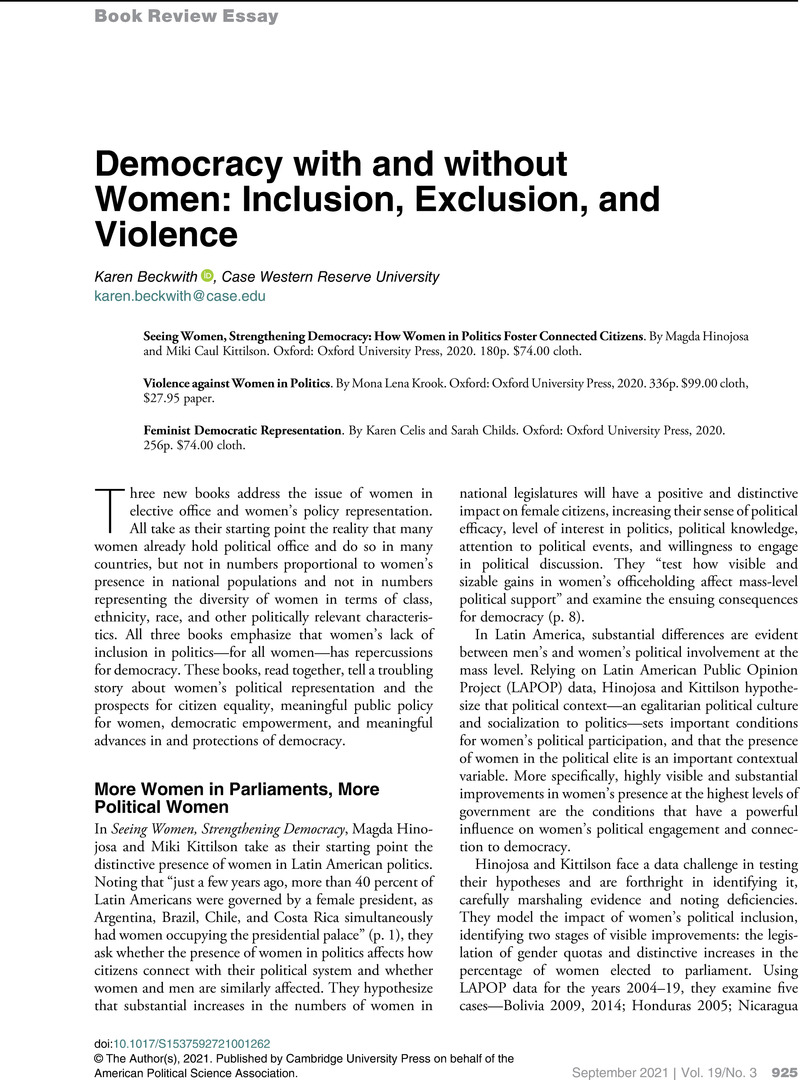No CrossRef data available.
Article contents
Democracy with and without Women: Inclusion, Exclusion, and Violence
Review products
Seeing Women, Strengthening Democracy: How Women in Politics Foster Connected Citizens. By HinojosaMagda and KittilsonMiki Caul. Oxford: Oxford University Press, 2020. 180p. $74.00 cloth.
Violence against Women in Politics. By KrookMona Lena. Oxford: Oxford University Press, 2020. 336p. $99.00 cloth, $27.95 paper.
Feminist Democratic Representation. By CelisKaren and ChildsSarah. Oxford: Oxford University Press, 2020. 256p. $74.00 cloth.
Published online by Cambridge University Press: 02 September 2021
Abstract
An abstract is not available for this content so a preview has been provided. Please use the Get access link above for information on how to access this content.

- Type
- Book Review Essay
- Information
- Copyright
- © The Author(s), 2021. Published by Cambridge University Press on behalf of the American Political Science Association
References
Beckwith, Karen. 2014. “Plotting the Path from One to the Other.” In Representation: The Case of Women, eds. Escobar-Lemmon, Maria and Taylor-Robinson, Michelle. Oxford: Oxford University Press.Google Scholar
Escobar-Lemmon, Maria, and Taylor-Robinson, Michelle, eds. 2014. Representation: The Case of Women. Oxford: Oxford University Press.CrossRefGoogle Scholar
Hawkesworth, Mary. 2003. “Congressional Enactments of Race-Gender.” American Political Science Review 97(4): 529–50.CrossRefGoogle Scholar
Hawkesworth, Mary. 2020. “Visibility Politics: Theorizing Racialized Gendering, Homosociality, and the Femicidal State.” Signs 45(2): 311–19.CrossRefGoogle Scholar
Htun, Mala. 2016. Inclusion without Representation in Latin America. New York: Cambridge University Press.CrossRefGoogle Scholar
Piven, Frances Fox, and Cloward, Richard A.. 1979. Poor People’s Movements. New York: Vintage.Google Scholar
Restrepo Sanin, Juliana. 2020. “Violence against Women in Politics: Latin America in an Era of Backlash.” Signs 45(21): 302–10.CrossRefGoogle Scholar
Schwindt-Bayer, Leslie A. 2010. Political Power and Women’s Representation in Latin America. Oxford: Oxford University Press.CrossRefGoogle Scholar
Shalhoub-Kevorkian, Nadera. 2003. “Reexamining Femicide: Breaking the Silence and Crossing ‘Scientific’ Borders.” Signs 28(2): 581–608.CrossRefGoogle Scholar
Strolovitch, Dara Z. 2007. Affirmative Advocacy. Chicago: University of Chicago Press.CrossRefGoogle Scholar
Wylie, Kristin N. 2018. Party Institutionalization and Women’s Representation in Democratic Brazil. New York: Cambridge University Press.CrossRefGoogle Scholar




